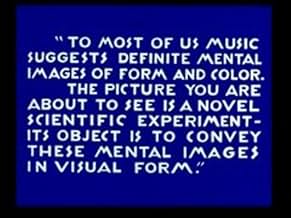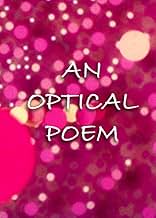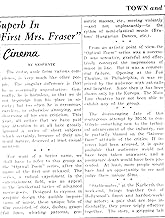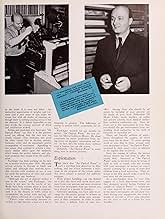Aggiungi una trama nella tua linguaMental imagery of music is visualized with two-dimensional shapes dancing to the rhythm of Franz Liszt's Hungarian Rhapsody No. 2.Mental imagery of music is visualized with two-dimensional shapes dancing to the rhythm of Franz Liszt's Hungarian Rhapsody No. 2.Mental imagery of music is visualized with two-dimensional shapes dancing to the rhythm of Franz Liszt's Hungarian Rhapsody No. 2.
- Regia
Recensioni in evidenza
10verbusen
Listed as a 1938 film but perhaps first shown in 1937 since the TCM website states that as the year audiences first viewed An Optical Poem, this was a pioneering animation short. I'm surprised I never watched it before the year 2019, TCM should be showing it more often (and other stop-motion independent shorts from the time). While watching this short I began to think of how it was made. It's using stop motion, taking a picture of the scene and then moving the items in the frame a slight bit at a time and taking another picture and so many thousands of times. TCM has a lot of information about this short. It was done with cut out paper patterns held together by fishing line, no computers back then! It could have been done with animation but when you realize it is being done with stop motion it adds credibility to the degree of work involved in producing the film. MGM, a very conservative studio, paid Oskar Fischinger $11,000 to make the film. Anything he had left over was his to keep. The only problem was there was nothing left over, so Oskar, while he may have wanted to make some money, did this one for the love of his art. It was not widely released and was used as a "prestige" item, playing for high end movie audiences, like as the TCM article states, "first-class ocean-liner passengers". Many at the time thought it would be nominated for an Academy Award (it was not). Mr Fischinger would have a falling out with MGM over the money made from the film that included a physical altercation with MGM staff and his arrest, he would only do 5 more independent shorts before losing interest in film-making and devoting his work to painting instead. MGM, which was using an outside studio before for its animated shorts at the time, the Harmon-Ising studio and their Happy Harmonies series, around the time of An Optical Poem, created their own animation department resulting in many future Oscar winners from the Tom and Jerry franchise. This is the story of An Optical Poem, quite an interesting one not only on how it was made and the level of sophistication it presented in 1937 with its high fidelity sound, brilliant technicolor photography and inspired use of stop motion animation, but for the way mainstream audiences and Hollywood basically rejected it as being too far ahead of its time. For film history buffs it marks an achievement in film making and a time capsule on the social attitudes towards modern artists in the 1930s. 10 of 10.
8tavm
After years of favoriting this on YouTube, I finally watched this M-G-M/Oskar Fischinger colored paper-animated short there. Done to the music of Franz Liszt's "Second Hungarian Rhapsody" (the same music Bugs Bunny would play in Rhapsody Rabbit), we see lots of circles, rectangles, and other shapes in space moving and appearing/disappearing to that music. Quite fascinating to watch and maybe it may have been the inspiration for Walt Disney's later feature length Fantasia a few years later. This seemed to be Fischinger's only film work for a major studio. It certainly seemed possibly too avant garde for the tastes of the public of the time! How many even know about this one? Anyway, that's a recommendation for An Optical Poem.
Just about anyone who's ever made a music video especially an abstract one owes a debt of gratitude to Oskar Fischinger. This short film is a charming rendition of Liszt's Second Hungarian Rhapsody set to a dazzling series of colored dots, lines, flashes and vivid visual effects that often look like a Piet Mondrian painting come to life. Paul Marquardt's often cheeky orchestration far different from the one usually heard adds a quite inventive series of tonal effects to the film that only underscores the rambunctious appeal of Fischinger's animation. I remember seeing films like this from the 1960's and not realizing anyone had done anything this imaginative with the same format thirty years earlier and I can't for the life of me imagine what unsuspecting moviegoers who caught this in 1937 on a program headlined by an MGM feature of the period made of it!
The tagline for Disney's 'Fantasia (1940)' read: "Hear the pictures! See the music!" This is, in effect, what Oskar Fischinger was doing with his animation – communicating music to the deaf, giving visual life to music using colours and geometric patterns. His approach, though later imitated by Walt Disney, was largely appreciated outside the mainstream. However, 'Allegretto (1936)' and 'An Optical Poem (1937)' were both commissioned by big studios – Paramount and MGM, respectively {however, the former film was inconceivably stifled into a black-and-white release}. It was a little novel, I'll admit, to see such an abstract cartoon presented under the MGM banner, and, indeed, it seems that the studio was understandably cautious; they bizarrely introduce 'An Optical Poem' as a "scientific" experiment.
Fischinger's film uses patterns of oscillating circles, paper cutouts dangling from invisible wires, synchronised to Franz Liszt's "Hungarian Rhapsody No. 2." The animation itself resembles a journey through outer space. The orbiting circles are akin to moons orbiting planets, planets orbiting the sun, and there's an unmistakable image of a comet hurtling across the night sky. The overall effect of the space-themed visuals and accompanying classical musical is not all that dissimilar to Kubrick's use of the "Blue Danube" waltz during '2001: A Space Odyssey (1968).' Fischinger seems to be suggesting that to fully articulate such magnificent music is beyond the grasp of our earthly minds – to do so, we must utilise objects far beyond our mortal scope. Most incredibly of all, Fischinger reconstructed these great objects using little more than coloured paper and wire.
Fischinger's film uses patterns of oscillating circles, paper cutouts dangling from invisible wires, synchronised to Franz Liszt's "Hungarian Rhapsody No. 2." The animation itself resembles a journey through outer space. The orbiting circles are akin to moons orbiting planets, planets orbiting the sun, and there's an unmistakable image of a comet hurtling across the night sky. The overall effect of the space-themed visuals and accompanying classical musical is not all that dissimilar to Kubrick's use of the "Blue Danube" waltz during '2001: A Space Odyssey (1968).' Fischinger seems to be suggesting that to fully articulate such magnificent music is beyond the grasp of our earthly minds – to do so, we must utilise objects far beyond our mortal scope. Most incredibly of all, Fischinger reconstructed these great objects using little more than coloured paper and wire.
It's an MGM animated short with Hungarian Rhapsody No. 2 by Franz Liszt playing. It's Technicolor. It's all bright colors and geometric shapes. It's a little experimental. It's interesting. Sometimes, the movement is pretty good, but other times, I want it to switch with the music tempo a lot more. One of the most compelling aspect of this piece of music is its many changes of tempo. The visuals need to match that better. This type of animated experiments have a long Hollywood history. Producer Oskar Fischinger would go on to do a sequence in Walt Disney's Fantasia (1940) which obviously drew inspiration from this.
Lo sapevi?
- QuizAs this was released two years before "Fantasia," it's reasonable to assume either Disney or someone who worked for him saw this and realized the possibilities of non-narrative animation set to classical music; certainly the "Toccata and Fugue in D Minor" sequence bears a striking similarity.
- Citazioni
Prologue (Title): To most of us music suggests definite mental images of form and color. The picture you are about to see is a novel scientific experiment - Its object is to convey these mental images in visual form.
I più visti
Accedi per valutare e creare un elenco di titoli salvati per ottenere consigli personalizzati
Dettagli
- Data di uscita
- Paese di origine
- Lingua
- Celebre anche come
- MGM Miniatures (1937-1938 Season) #5: An Optical Poem
- Azienda produttrice
- Vedi altri crediti dell’azienda su IMDbPro
- Tempo di esecuzione6 minuti
- Proporzioni
- 1.37 : 1
Contribuisci a questa pagina
Suggerisci una modifica o aggiungi i contenuti mancanti




















